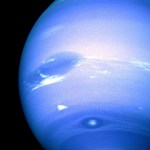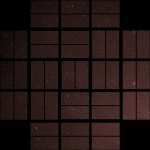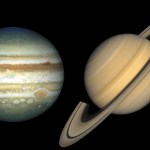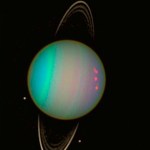Neptune
The Kepler 2 mission serendipitously observed Neptune about a year ago.
The images were posted on the K2 website, but according to the website stat like nobody shared them, which sucks.
The animation was just shown at the Division for Planetary Sciences meeting, #DPS15, in DC so it is time to show it again.
Enjoy.
Kepler Observes Neptune Dance with Its Moons
Check Emily Lakdwalla's planetary blog for #DPS15 news
Have you complained about the weather recently? On the gas giants at the edges of our solar system, Uranus and Neptune, hurricane-like storm systems as big around as Earth blow 1000 km/h winds for years on end.
Voyager II image of Neptune, showing storm features. Image: NASA
But wait…What exactly constitutes weather on a giant gas planet? Here on planet Earth, there is a clearly delineated gas layer enveloping the solid/liquid layer we call home. Our weather arises from our planet’s rotation and the solar heating of its surfaces. On a rapidly-rotating gas planet (a day on Neptune is 16 hours…
"This one will look like a jellybean," the session director warns us. "Or, you know, when you empty a hole punch? The circles of paper that fall out? One of those." She's talking about Neptune, and I am about to step, carefully, up a ladder painted industrial yellow and wheeled into place in front of the centenarian eyepiece of the 60" Hale telescope at Mt. Wilson Observatory, incidentally the very place where Edwin Hubble, in 1925, discovered that our galaxy was not the entirety of the Universe, and later, that our Universe was expanding.
A jellybean, a piece of confetti: it seems her…
"Don't go around saying the world owes you a living. The world owes you nothing. It was here first." -Mark Twain
So, you've been around a while, seen all sorts of things, and learned an awful lot about the world, solar system and Universe that we live in. But how well do you know it, really?
Image credit: NASA / Lunar and Planetary Laboratory.
To scale and in order, these are the eight planets you know so well. There are the four rocky worlds of our inner solar system: Mercury, Venus, Earth, and Mars, and the four gas giants that dominate the outer solar system: Jupiter, Saturn, Uranus, and…
"Some prophecies are self-fulfilling
But I've had to work for all of mine
Better times will come to me, God willing
Cause I can't leave this world behind" -Josh Ritter
You sure can't leave this world behind. At least, not very easily. The reason for it, of course, is gravity.
Image Credit: Physclips, via the University of New South Wales' School of Physics.
Here on the surface of the Earth, the gravitational potential well is pretty large; large enough that there's no easy way off. Sure, you can pour a huge amount of energy into a rocket to try and overcome this gravitational potential…
Canadian-French Hawaii Telescope transit observations show super-earth is probably a mini-neptune
Ray Jay reports from Torino that his group has CFHT observations on GJ 1214b transits, suggesting it has a H/He atmosphere, and is therefore probably not a "super-earth", but more likely an ice giant with neptune like atmosphere.
This is interesting, suggesting indirectly the planet migrated from beyond the ice line and did some gas accretion onto its core before reaching the inner system.
Looking forward to seeing the paper.
Jet-lag and grading fatigue (plus being on the other coast for three days) mean that I haven't had much time lately to sit down with the sprogs and have a conversation about science. However, Casa Free-Ride presents me with clues which suggest that the Free-Ride offspring have been thinking about science.
The younger Free-Ride offspring's backpack, for example, yielded a water quality report:
The dry-erase calendar on the door between the kitchen and garage still retains visual aids from a conversation Dr. Free-Ride's better half seems to have had with the sprogs about genetics:
And, on…
(This is adapted from my public lecture, Afraid of the Dark: How We Know What We Can't See.)
Let's go back over 200 years ago, to 1781. William Herschel (left) discovered the planet Uranus, noticing that an object, as bright as a star, was actually moving relative to the other stars. The other five inner planets (besides Earth) were known for over 2000 years before that. But it was thought for a long time that Saturn was the farthest one.
But it clearly isn't; as you can see with modern telescopes, Uranus is a super-interesting planet, rotating on its side, surrounded by rings and moons.…




